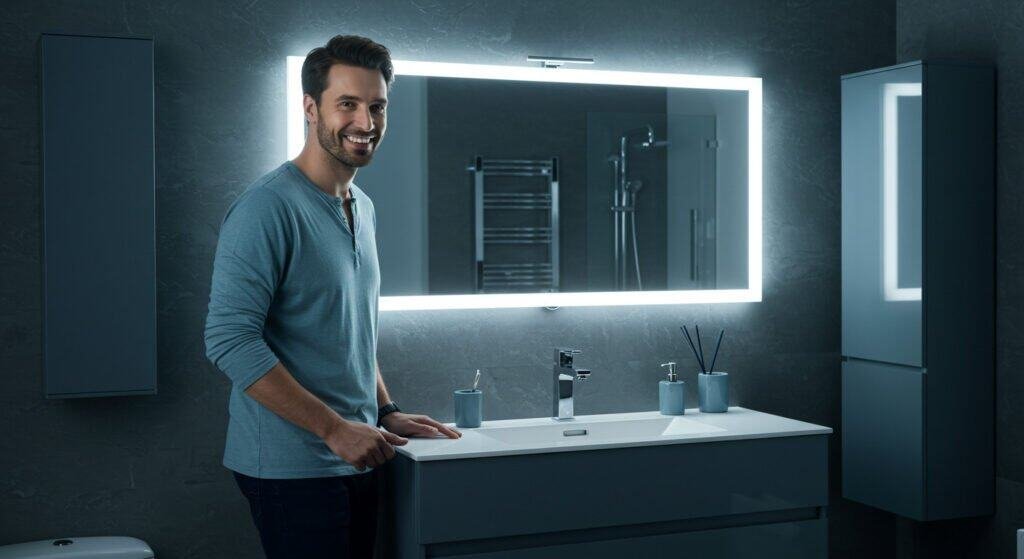Hanging a mirror can be a challenge if it doesn’t have hooks. How to hang a mirror without hooks on the back? Don’t worry! There are several ways to do it safely and beautifully.
You can hang a mirror without hooks using adhesive strips, construction adhesive, mirror clips, or a French cleat. The best method depends on the mirror’s weight, size, and the wall type. These methods work for different types of mirrors, from a small bathroom mirror to a large led mirror.
Hanging a mirror can be tricky. But with the right method, you can do it safely and easily. Keep reading to find out more..
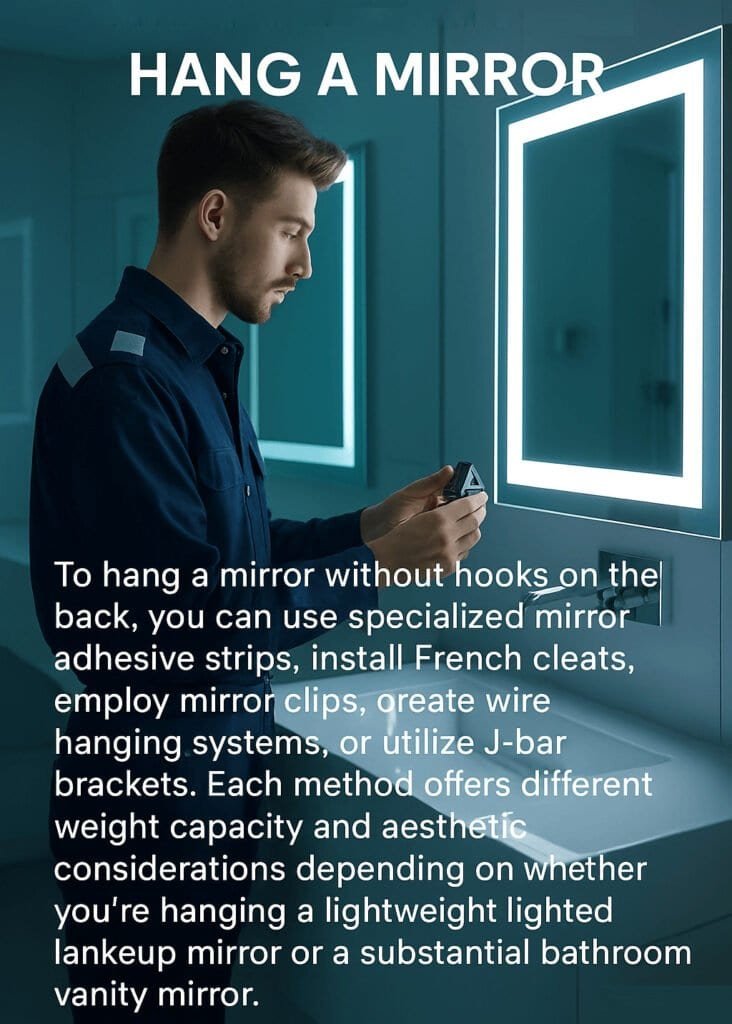
Why are hooks sometimes not the best option?
Hooks seem simple, but are they always ideal? Let’s consider the drawbacks of using hooks.
Hooks require drilling, which can damage walls and be difficult to repair. They may not be suitable for heavy mirrors or certain wall types like plaster or tile. Plus, hooks can be visible and detract from the mirror’s aesthetic, especially with a modern design like some modern lighted mirrors for bathrooms.
I always wonder if hooks are the best choice, especially with delicate wall surfaces or heavy mirrors. Who wants to drill holes in walls? Then you’re stuck with the patchwork if you need to move it. When I was setting up a display of bathroom vanity mirrors at a trade show, I had to explore alternatives to hooks because I wanted a clean, damage-free look.
The type of wall also matters a great deal. For example, plaster walls are brittle and easily crack with the pressure of drilling. Tile walls are tough and risky to drill because they can chip. What about the mirror itself? A beautiful, long rectangular mirror in a bathroom may look odd with visible hooks. With this in mind, it’s important to know when studs, nails, and glue are appropriate and when to bypass the hooks altogether to find a safer and better solution to hang your mirror.
Here’s a table to break down when hooks might not be the best:
| Scenario | Why Hooks Aren’t Ideal |
|---|---|
| Delicate Walls (Plaster) | Risk of cracking and crumbling during drilling |
| Tile Walls | Difficult to drill without chipping or damaging tiles |
| Heavy Mirrors | Hooks might not provide sufficient support |
| Aesthetic Concerns | Visible hooks can detract from the mirror’s appearance |
What are the best alternatives to using hooks?
Alternatives include adhesive strips for lighter mirrors, construction adhesive for heavier ones, mirror clips for a secure hold, and French cleats for a professional look. Each has its pros and cons based on mirror weight and wall type. These options work for various mirrors, including a lighted makeup mirror or a simple glass mirror.
You may want to use adhesive strips, which are excellent for lighter mirrors and offer a simple, damage-free solution. Be sure to get the right weight capacity for your mirror and apply them correctly to a clean, smooth surface. Construction adhesive is another method for heavier mirrors; however, you need to apply it carefully, and it’s a nightmare to remove later.
Mirror mounting clips offer a secure hold and can be adjusted to accommodate different mirror sizes and shapes. Lastly, French cleats provide a professional and sturdy mounting system, ideal for larger or heavier mirrors that require extra support.
I remember when I was helping a friend install a vanity mirror with led lights in her bathroom. She wanted a modern look, and we didn’t want to damage the newly tiled walls. We decided to use a combination of adhesive strips and mirror clips.
With the lighter mirrors, we used heavy-duty adhesive strips. We made sure to clean the wall surface thoroughly before applying the strips. With the larger mirrors, we installed mirror clips designed to provide extra support and stability. Using these alternate methods, we were able to hang the mirrors securely without drilling any holes.
Let’s look at the pros and cons of each option:
| Method | Pros | Cons | Best For |
|---|---|---|---|
| Adhesive Strips | Easy to apply, no damage to walls | Limited weight capacity, may not work on textured surfaces | Light mirrors on smooth surfaces |
| Construction Adhesive | Strong bond, suitable for heavier mirrors | Difficult to remove, can damage walls upon removal | Heavy mirrors requiring a permanent solution |
| Mirror Clips | Secure hold, adjustable, can accommodate different mirror sizes | May be visible, requires screws | Mirrors needing extra support and adjustability |
| French Cleat | Professional look, very sturdy | Requires precise installation, more complex than other methods | Large, heavy mirrors needing a secure mount |

How do I choose the right method for my mirror and wall?
You need to choose the right method for your mirror’s weight and your wall type.
Assess your mirror’s weight. Use adhesive strips for light mirrors (under 5 lbs), construction adhesive or mirror clips for medium-weight mirrors (5-20 lbs), and French cleats for heavy mirrors (over 20 lbs). Also, consider your wall type: smooth surfaces work best for adhesives, while sturdy walls are needed for clips and cleats. This applies whether you’re hanging a small bathroom mirror or a large wall mirror with lights.
It all starts with picking the right hanging method for your mirror and your wall. The first thing you want to consider is the weight of your mirror because that’s going to direct you toward the type of hanging solution you’re going to use. If you have a lightweight mirror (like less than 5 pounds) then adhesive strips are a great, convenient and damage-free way to hang that mirror.
However, it’s essential to choose adhesive strips specifically designed for mirrors and to follow the manufacturer’s instructions carefully to ensure a secure hold. For mirrors of medium weight, ranging from 5 to 20 pounds, construction adhesive or mirror clips may be more appropriate. Construction adhesive provides a strong and durable bond, while mirror clips offer added support and stability.
I recently installed a series of decorative mirrors in a hotel lobby. When I thought through exactly what was involved, I had to consider the weight of each mirror along with the type of wall to which it would be mounted. Some of them were backlit mirror designs, which added to the weight. For the smaller, lightweight mirrors, I went with heavy-duty adhesive strips. They gave a clean, seamless look and we didn’t have to drill any holes. For the larger, heavier mirrors, I used a combination of construction adhesive and mirror clips. They didn’t budge and were securely anchored to the wall. By taking the time to think through exactly what was involved in each installation, the results were professional and long-lasting.
Here’s a quick guide:
| Mirror Weight | Recommended Method(s) | Wall Type Considerations |
|---|---|---|
| Under 5 lbs | Adhesive Strips | Smooth surfaces are best for optimal adhesion |
| 5-20 lbs | Construction Adhesive, Mirror Clips | Sturdy walls are needed for secure attachment |
| Over 20 lbs | French Cleat | Requires a strong and stable wall structure |
How to hang a large mirror?
Large mirrors make a statement, but you need to be careful when hanging them.
For large mirrors, use a French cleat or heavy-duty mirror clips. Ensure the wall can support the weight. Always use a level to guarantee it’s straight. A large led mirror requires even more support due to the added weight of the lighting components.
When hanging a large mirror, you need to plan and execute carefully to make sure it’s safe and looks good. Because they are so big and heavy, you need a hanging method that provides the most support. French cleats are the best choice for hanging large mirrors because they distribute the weight evenly across the wall and give you a safe, secure, and professional looking installation. Alternatively, heavy-duty mirror clips can also be used to hang large mirrors, providing a reliable and adjustable solution.
I was once involved in a project where we had to hang an oversized led bathroom mirror in a luxury hotel suite. The mirror was not only large but also quite heavy due to the integrated LED lighting and defogging features. We opted for a French cleat system, which we carefully installed to ensure it was perfectly level and securely attached to the wall studs. In addition to the French cleat, we also used heavy-duty mirror clips along the bottom edge of the mirror for added support and stability. By combining these two methods, we were able to hang the mirror safely and securely, creating a stunning focal point in the bathroom.
Key considerations:
- Use a French cleat for even weight distribution.
- Consider heavy-duty mirror clips for added support.
- Ensure the wall can support the mirror’s weight.
- Use a level for perfect alignment.
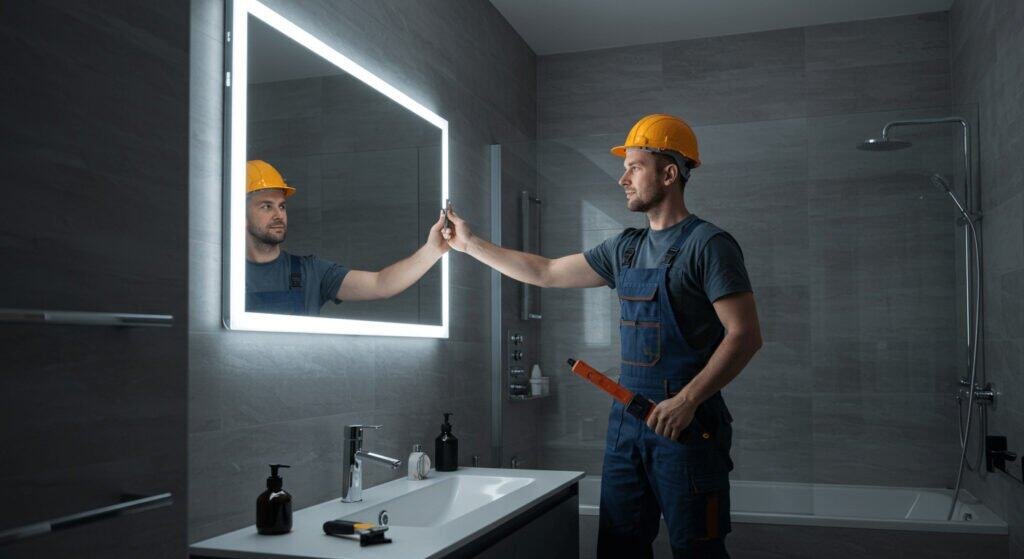
How to hang mirror on wall without nails?
Adhesive strips are your best bet for hanging mirrors without nails. Use heavy-duty strips designed for mirrors. Ensure the wall is clean and smooth for optimal adhesion. This works well for lighter mirrors, like a small bathroom mirror.
If you want to hang a mirror without nails, this is perfect for you. Hanging a mirror with adhesive strips offers a quick and easy solution that doesn’t require nails, screws, or any other hardware. Adhesive strips are a great choice for hanging a lightweight mirror because they’re easy to use and strong enough to support the weight of the mirror when used properly. When you use adhesive strips to hang a mirror, make sure you choose strips designed specifically for mirrors and ensure the weight capacity is higher than the weight of your mirror.
Tips for nail-free hanging:
- Use heavy-duty adhesive strips designed for mirrors.
- Clean the wall surface thoroughly before application.
- Ensure the strips can support the mirror’s weight.
- Press firmly and hold in place for several minutes.
How to hang a heavy mirror on a brick wall?
Hanging heavy items on brick walls is different than hanging heavy items on drywall.
Drill pilot holes into the brick and use masonry screws. A French cleat is also a good option for distributing the weight. Make sure your hardware is rated for the weight of the mirror. This is especially important for a large led mirror.
If you want to hang a heavy mirror on a brick wall, here’s what you need to know. It can be tough to hang a heavy mirror on a brick wall because brick is a hard, dense material. You need to use special techniques and hardware designed specifically for hanging heavy items on brick walls to ensure a secure, long-lasting installation. The first step is drilling pilot holes into the brick so you can insert masonry screws or anchors that will give you a strong, reliable hold. When you drill into brick, you will use a hammer drill and a masonry drill bit that is slightly smaller in diameter than the screws or anchors you plan to use.
I once had to hang a large wall mirror with lights in a loft apartment with exposed brick walls. The mirror was incredibly heavy, and I knew that I needed to use a hanging method that would provide maximum support and stability. You drill pilot holes in the brick using a hammer drill and a masonry drill bit. Then you screw masonry screws into the pilot holes (making sure that they are securely anchored in the brick). To distribute the weight of the mirror evenly, you use a French cleat system, which you attach to the wall using additional masonry screws. The combination of masonry screws and a French cleat gives you a rock-solid installation that can easily support the weight of a heavy mirror.
Key steps for brick wall hanging:
- Drill pilot holes into the brick using a hammer drill.
- Use masonry screws or anchors.
- Consider a French cleat for weight distribution.
- Ensure hardware is rated for the mirror’s weight.
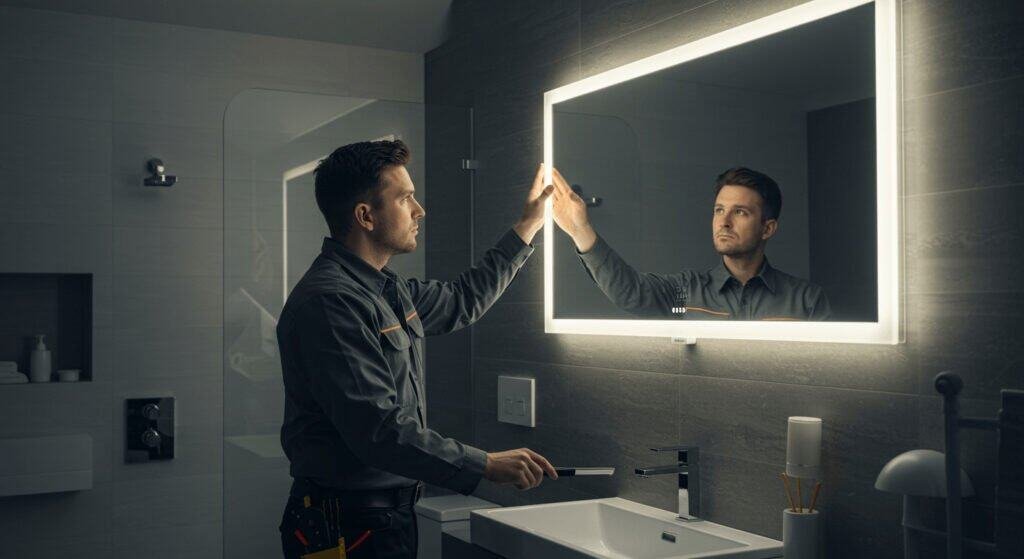
How to hang a frameless mirror on a wall?
Frameless mirrors offer a sleek look. Hanging them requires a delicate touch.
Use mirror clips specifically designed for frameless mirrors. These clips hold the mirror securely without damaging the edges. Construction adhesive can also be used in conjunction with mirror clips for added support. A backlit mirror often has a frameless design to maximize the light’s effect.
Hanging frameless mirrors, like the one I had, without damaging the edges (which is the most critical part to keep looking good), requires a delicate touch. A great way to hang a frameless mirror is to use mirror clips. You don’t have to drill holes, and you don’t have to use nails. Mirror clips are the perfect solution for hanging frameless mirrors. The key when using mirror clips to hang a frameless mirror is to select clips made for hanging this type of mirror. Make sure the clips have soft, non-abrasive pads that protect the edges of the mirror.
Steps for hanging a frameless mirror:
- Use mirror clips designed for frameless mirrors.
- Ensure the clips have soft, non-abrasive pads.
- Position the clips evenly along the edges.
- Avoid overtightening the screws to prevent cracking.
How high to hang full length mirror?
The height of a full-length mirror indirectly affects its functionality and appearance.
Hang it so the center of the mirror is at eye level. This usually means the top of the mirror is a few inches below the ceiling. Ensure you can see your entire reflection. Think about where you will place your room mirror.
It’s important to know how high to hang a full-length mirror, whether for functionality or decorative purposes. When hanging the mirror, you want the center of its reflective surface to be at eye level so you can see your entire reflection without stooping or craning your neck. A good rule of thumb is to position the top of the mirror a few inches below the ceiling, which gives you enough room to XAX see your full figure.
When I was helping a client design her dressing room, we had to carefully consider the placement of the full-length mirror. We wanted to ensure that she could see herself from head to toe without any distortion or obstruction. We measured her height and determined that the center of the mirror should be positioned at approximately 5’4” from the floor. We adjusted the height of the mirror so the top of the mirror was a few inches below the ceiling. The result was a perfectly placed full-length mirror that allowed her to see her entire body without any distortion.
Guidelines for full-length mirror height:
- Center of the mirror at eye level.
- Top of the mirror a few inches below the ceiling.
- Ensure you can see your entire reflection.
- Consider the room’s layout and furniture placement.
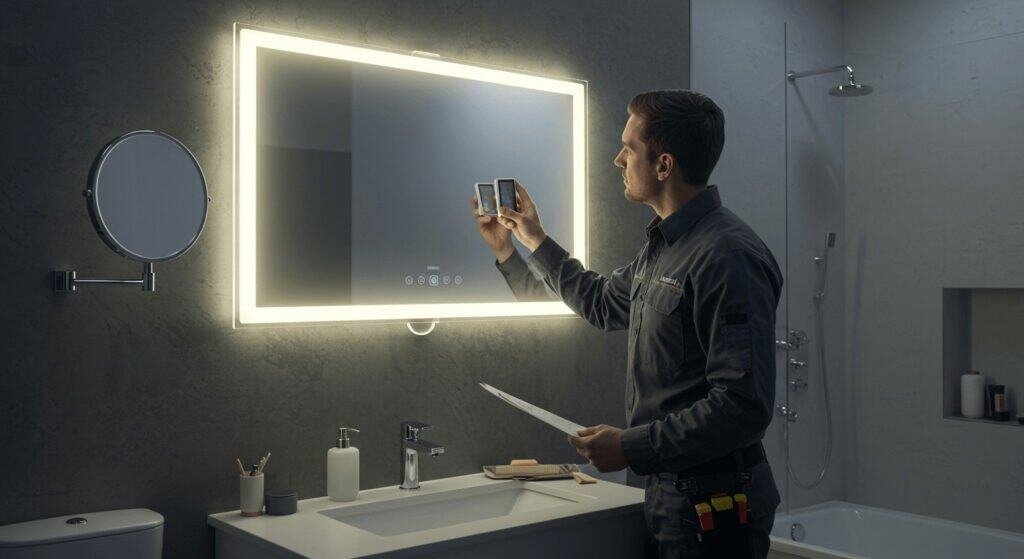
How do you hang a backless mirror?
Mirrors with no backing are a different story. They require a little extra love to protect the silvering.
Use mirror clips with rubber or felt pads to protect the back. Construction adhesive can also be used, but apply it carefully to avoid damaging the reflective surface. A light up vanity mirror may not have a full backing to allow for better light diffusion.
Hanging a mirror without a backing requires special care to protect the delicate silvering on the back and prevent damage to the reflective surface. Mirror clips are an excellent choice for hanging backless mirrors, as they provide a secure and adjustable solution without the need for drilling or nails. When using mirror clips for this purpose, it’s essential to select clips that have soft, non-abrasive rubber or felt pads to cushion the back of the mirror and prevent scratches or abrasions.
Tips for hanging a backless mirror:
- Use mirror clips with rubber or felt pads.
- Avoid applying pressure to the back of the mirror.
- Clean the wall surface thoroughly before installation.
- Handle the mirror with care to prevent damage.
Can I use command strips to hang a mirror?
Command strips can work for very light mirrors. Use strips rated for more than the mirror’s weight. However, for safety, consider other methods for heavier or more valuable mirrors. A small bathroom mirror might be okay, but avoid using them for a large led bathroom mirror.
Command strips offer a useful, convenient, and damage-free way to hang a lightweight mirror if you don’t want to use nails, screws, or other hardware. The strips are designed to stick to painted walls, tile, glass, and more. You can remove them with no damage or sticky residue left behind. Here’s the catch. Command strips will only hold a certain amount of weight, so they won’t work for a heavy or valuable mirror.
Considerations for using Command strips:
- Only use for very light mirrors.
- Choose strips rated for more than the mirror’s weight.
- Clean the wall surface thoroughly before application.
- Not recommended for heavy or valuable mirrors.

What do I attach to the back of a mirror to hang?
You can attach D-rings or hanging wire to the back of the mirror. Use a strong adhesive specifically designed for mirrors. Make sure the adhesive is fully cured before hanging. This is useful for creating custom room mirror ideas.
You can add your own hanging hardware to the back of the mirror, and this is a neat way to do it because you can make it as custom as you want. Two of the popular methods people use are D-rings, and hanging wire. These options will allow you to have a super secure method to hang the mirror on the wall. The key is to make sure you use a strong adhesive to attach the D-rings or hanging wire to the back of the mirror. Look specifically for an adhesive that’s made for mirrors that’s going to give you a great, durable, and long-lasting bond.
Steps for attaching hanging hardware:
- Clean the back of the mirror with rubbing alcohol.
- Use a strong adhesive designed for mirrors.
- Position D-rings or hanging wire evenly.
- Allow the adhesive to fully cure before hanging.
Conclusion
Hanging a mirror without hooks is possible with the right method. Consider your mirror’s weight, wall type, and desired look for a secure and stylish display. Whether it’s a led bathroom mirro or a light up vanity mirror, these tips will help you achieve the perfect placement.
- Clik here to know What Is Copper Free Mirror?
- If you donot know how too choose the right bathroom height click here.
- Know more about LED bathroom mirror Problems
- Clik here to know why Touch Sensor Mirror Not Working
- Clik here to know What Are Standard Vanity Mirror Sizes?
- Clik here to know Why Are Mirrors So Expensive?
- Clik here to know Do LED Mirrors Need Electricity?
- Clik here to know Is a Lighted Mirror Enough Light for a Bathroom?

